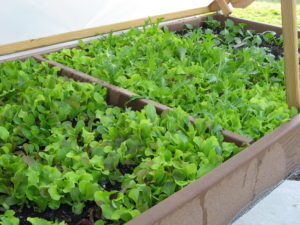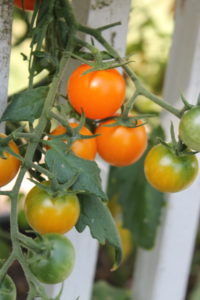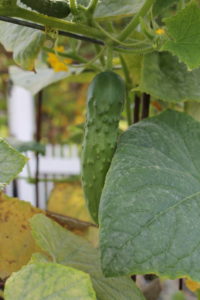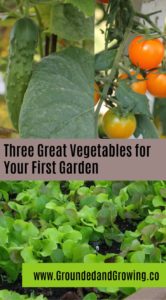Are visions of growing a vegetable garden dancing in your head? Garden catalogs and websites are great, but the choices can be overwhelming. Here are my top three crops for new gardeners with tips for growing, suggested cultivars and potential challenges.
Don’t leave me alone with a seed catalog– or worse– a store display of garden seeds!
My eyes are much bigger than my garden. You’d think I’d learn, but every year I buy too much. And it’s not like I don’t know better. This isn’t my first garden. If you’re taking the leap and planting your first vegetable garden this year, how do you avoid a similar fate?
When planning your first garden, it’s tough to answer the question “What should I plant?” The possibilities are quite literally endless. Catalogs and garden centers offer new varieties each year. Do you try those, or plant an old reliable variety?
As far as what to plant, my first big recommendation is to plant what you and your family will eat. I have vivid memories of eating a bright lime green leaf right out of my family’s garden when I was little that I don’t remember ever eating at meals. I now know that the green leaf was Swiss chard. But I still have no idea why my mom and dad planted it year in and year out and never used it.
Once you’ve identified family favorites, what varieties will you plant? If growing a garden is a new adventure for you, I highly encourage you to stick with “old reliable” varieties at least for your first year or two. It’s all about getting some success under your belt before moving on to bigger challenges.
If you’re new to gardening, my other big recommendation is to start small. I know from personal experience and questions I’ve been asked over the years that everyone wants to plant a garden in the spring. The temptation to tear up your backyard is there. Even more so the colder, snowier and longer winter has been.
You may have to find a trusted friend or spouse to reign you in and be the “responsible adult” at garden centers if you tend to go a bit overboard like I do. But trust me– that giant garden you were so excited to work on in the spring will not be as enticing when it’s 100 degrees in the middle of summer. I don’t want your first adventure in gardening to be your last!
Here are my three top choices for relatively easy and quick crops to grow as a new gardener. Nothing is completely problem-proof, so I’m also including common issues with each crop.
I’m also including my three favorite cultivars for each crop. Why three? Well, because for some of these I could give you pages of favorites, and then you will either 1) plant way too much or 2) suffer from “paralysis by analysis” and never choose, and never plant anything. I’m trying to keep it manageable. Remember, we are going for a small win here. No need to feed your whole neighborhood.
Lettuce or Salad Mix
This is a crop you don’t even need a garden to grow. Plus lettuce and salad mix are a great choice for early spring planting; they tolerate chilly temps and even a light frost. Just get yourself a fairly large pot; I’d say at least twelve inches in diameter to make your effort worthwhile. Fill it with a good quality potting mix and sprinkle seeds on top. Water and wait. You can speed up germination by putting plastic wrap over the top to capture the sun’s warmth. Be sure to vent it on super sunny days and remove it entirely once the seeds sprout so you don’t cook the young plants!
Planting lettuce and salad mix in a pot or better yet, a salad table has one huge advantage– so huge that I don’t plant lettuce in the ground anymore. It’s much easier to keep rabbits from eating all your lettuce when it’s not in the ground. I’ve tried all sorts of fencing to keep rabbits out of lettuce planted in my raised beds and it never works. They find a way. But using a pot or salad table, you can grow the lettuce completely out of reach of any rabbit.
I grow lettuce and salad mix as a crop that you harvest with scissors rather than individual heads of lettuce. When the leaves are as big as you want them, cut them off with scissors but leave a half an inch or so at the bottom so there is enough of the plant left for it to regrow. You should be able to harvest this way at least twice before needing to replant.
Lettuce and salad mix will tend to go to seed (called bolting) and become overwhelmingly bitter as the weather gets hot. If you have your crop planted in a moveable planter, you can move it into the shade and get several more weeks of edible leaves.
Varieties:

Salad mix grows out of reach of rabbits in my salad table.
I don’t think I’ve purchased the same salad mix twice. This is a situation where I simply cannot pick three to recommend. There are too many wonderful choices out there, and I really don’t think you can go wrong. I look for mixes that include a variety of leaf shapes and colors to make my salads more interesting. If you don’t see a mix you like, don’t be afraid to buy several packets of different leaf lettuces and create your own mix.
You may see the term “mesclun mix” and wonder if it’s different than a packet of mixed lettuce seeds. Mesculn is a salad mix that includes greens other than lettuce. They can include things like arugula, mustard, beets, endive, radicchio, kale and just about any other crop where the leaf is consumed. Every seed company out there has it’s own mesclun mix. Some will be very mild, others more spicy or bitter. Try several and figure out what your taste buds prefer.
Cherry Tomatoes
Tomatoes seem like they should be easy; they’re probably one of the most common plants in home vegetable gardens. But the reality is that tomatoes can be tough to grow. They get a whole host of diseases. The weather can also affect if you have any tomatoes to harvest. Large beefsteak type tomatoes typically ripen late in the season, making that wait for a juicy homegrown tomato even longer and more excruciating.
Cherry (or grape) tomatoes are what I would consider a good beginner tomato. They are among the earliest to ripen among all types of tomatoes. They also produce a ton of fruit per plant. You will get your fill and have plenty to share with friends. There is some size variation among cherry tomatoes. Check out those labeled “cocktail” tomatoes. They have the earliness of cherry tomatoes but they are bigger than most cherry or grape tomatoes and can even be sliced onto a sandwich.
Planting tomatoes with plenty of space between plants to allow for good air circulation will help prevent or at least lessen many of the common fungal tomato diseases. Also remember to water tomatoes at the base of the plant to avoid wetting the foliage. Wetting the leaves helps to spread any fungal disease that might be present.
Tomatoes are a great choice for container plantings, just make sure the container holds at least five gallons of soil mix. A container as simple as a repurposed five gallon bucket works well for growing tomatoes. If you’re looking to expand your growing options check out this post for more details about my favorite containers for tomatoes.
Varieties:

I plant different tomato varieties each year, but one of them is always ‘Sunsugar’.
‘Sunsugar’– Easily one of the sweetest cherry tomatoes I’ve ever tasted. One plant will produce plenty for a typical family of four.
‘Juliet’– An All-America Selections winner; a classic grape tomato that produces gobs of near perfect oval-shaped fruits. A friend of mine that exhibits vegetables in the state fair grows this cultivar year in and year out because its fruits are so consistent (when showing vegetables you want things as identical as possible). But they don’t just look nice they taste great too.
‘Supersweet 100’– I’m not sure what the “100” means in the name. Maybe that you will get 100 pounds of fruit from one plant? It sure seems like it. Like the name suggests, these are extremely sweet cherry tomatoes and they produce abundantly.
Cucumbers
Cucumbers are a favorite in my house. They are relatively quick to produce a crop, with most cultivars ready to harvest in less than 60 days. The vines need some support to grow on, but other than that as long as you keep the vines picked they will keep on producing. If you let cucumbers stay on the vine until they turn yellow/orange the vine won’t produce more fruit. They can also be sensitive to drought and develop bitterness if they don’t get enough water in hot weather. One summer I tried an heirloom variety called ‘White Wonder’ with white skin and it was bitter all summer, no matter how much I watered it. You’ll never see that variety in my garden again!
If you hate eating cucumbers with thick skin or hate peeling them, try English or burpless cucumbers that have a thin skin. You may recognize them as the extra long cucumbers sold encased in plastic wrap or the “baby cucumbers” in the produce section.
Cucumbers do attract some destructive pests, probably the worst being the cucumber beetle. These are the yellow beetles with black stripes or spots you may see in your cucumbers. They feed on and damage cucumber plants and fruits. Younger plants are more likely to be killed by feeding damage. These beetles can also spread bacterial wilt which kills plants of any age.
You can exclude these beetles using floating row cover, which is a lightweight fabric that will physically exclude the beetles and prevent them from damaging your plants. You do need to open the cover periodically to let bees and other insects pollinate most cucumbers so you have fruit to harvest later.
I’m not a big fan of spraying any sort of pesticide on my vegetable garden. Part of why I grow my own vegetables is to avoid added chemicals. But cucumber beetles are one of the few pests I will spray for if they get bad enough. They can potentially destroy your harvest if you don’t get them under control. This article from University of Minnesota has great information on chemical control of cucumber beetles, including how to spray without harming beneficial insects like bees.
Varieties:

‘Straight Eight’ cucumber a day or two before it’s ready for picking.
‘Straight Eight’– A classic cucumber cultivar. An All-America Selections winner, this is a great all-purpose cucumber.
‘Burpless Bush’– English, or burpless cucumbers are nearly seedless since they don’t need pollination to set fruit. If you have problems with cucumber beetle this means you could keep these plants covered with floating row cover and not have to worry about opening the cover to let pollinators in. They have a smoother, thinner skin than a standard cucumber like ‘Straight Eight’. Their thin skin is fragile– which is why these cucumbers are sold wrapped in plastic at the grocery store. ‘Burpless Bush’ produces 10″ fruits and is suitable for containers and small spaces since bush-type cucumbers have shorter vines than standard cultivars. They will still benefit from some staking or trellising.
‘Diva’– Another All-America Selections winner, this is a small (5-7″) burpless cucumber with resistance to several common cucumber diseases.
These are the three crops that I think are the easiest ones for a beginning gardener– but you may or may not agree. You may not even like these vegetables! And that’s perfectly ok. In the coming weeks I’ll share some information on some vegetables that maybe aren’t the easiest, but they’re not impossible.
Regardless of what you plant, my two biggest recommendations still are 1) plant what you and your family will eat and 2) start small. Even if you are not a new gardener, favorites change and life continually changes. I’ve learned by trial and error in my own garden that I don’t need to till up half my yard to have a vegetable garden. I never thought I’d say it but I’ve grown to love a smaller garden because it’s easier to manage along with everything else competing for my attention these days. I can enjoy the garden rather than seeing it as another chore– I hope you can find the joy in it too!
If you liked this post, please subscribe to Grounded and Growing today and receive your copy of “15 Tips to Become a '15 Minute Gardener'” so you can spend less time working ON your garden and more time enjoying being IN your garden.! It’s absolutely free. When you join the Grounded and Growing community, you’ll finally take the garden off your “To-Do” list and allow yourself time to enjoy your garden and savor the peace and serenity there. I tell subscribers about new posts as soon as I hit ‘publish’ and send weekly-ish updates on what’s going on in my garden– good, bad AND ugly.

All Rights Reserved. © 2018 Jennifer Schultz Nelson.
I second ‘Supersweet 100″. Wonderful flavor, huge yield. The only reason any of them make it into the kitchen (instead of being eaten in the garden) is that they produce so much fruit!
That’s exactly how any and all cherry tomatoes are treated at our house! My son eats them double-fisted! The other day he asked if he could have some tomatoes and I said sure without looking at how many he was eating. He ate the two pints I had just bought at the grocery store!